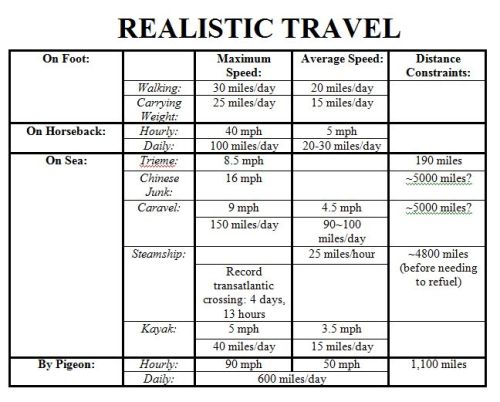Where Every Scroll is a New Adventure
Writing Ref - Blog Posts
As a writer, this makes me happy
List of British words not widely used in the United States. Lists of words having different meanings in American and British English. List of American words not widely used in the United Kingdom.
Awesome Sites and Links for Writers
Just about every writer out there has several go-to websites that they use when it comes to their writing. Be it for creativity, writer’s block, to put you in the mood or general writing help. These are mine and I listed them in hopes that you’ll find something that you’ll like or find something useful. I’ve also included some websites that sounded interesting, but I haven’t tried out yet.
Spelling & Grammar
Grammar Girl – Grammar Girl’s famous Quick and Dirty Tips (delivered via blog or podcast) will help you keep your creative writing error free.
The Owl – is Purdue University’s Online Writing Lab (OWL), an academic source from Purdue University (which is in West Lafayette, Indiana, U.S.). It’s contains plenty of grammar guides, style tips and other information that can help with your writing, it’s especially great for academics.
Tip of My Tongue — have you ever had trouble of thinking of a specific word that you can’t remember what it is? Well, this site will help you narrow down your thoughts and find that word you’ve been looking for. It can be extremely frustrating when you have to stop writing because you get a stuck on a word, so this should help cut that down.
Free Rice – is a great way to test your vocabulary knowledge. What’s even better about this site is that with every correct answer, they donate 10 grains of rice to the United Nations World Food Program. So, please disable your adblock since they use the ads on the site to generate the money to buy the rice.
HyperGrammar – is from the University of Ottawa (a bilingual public research university in Ottawa, Ontario, Canada) that offers up a one-stop guide for proper spelling, structure, and punctuation. Being that this comes from a Canadian university, that means that they use standard Oxford English Dictionary spelling. Basically that means you’ll get British English, which differs slightly from formal American English.
AutoCrit – the AutoCrit Editing Wizard analyzes your manuscript to identify areas for improvement, including pacing and momentum, dialogue, strong writing, word choice and repetition. It also provides a number of other writing resources as well. It’s not free, but they do offer 200 characters for analysis at no charge. It’s $29.97 per month or $359.64 for an annual membership.
ProWritingAid – is another automatic editing tool that analyzes your writing and produces reports on areas such as overused words, writing style, sentence length, grammar and repeated words and phrases. They offer a free sample, but you have to make an account to try it out. It’s $3.33 per month ($40 annually, or less if you purchase a longer license).
Writer’s Digest – learn how to improve your writing, find an agent, and even get published with the help of the varied blogs on this site.
Paper Rater – uses Artificial Intelligence to improve your writing. It includes grammar, plagiarism, and spelling check, along with word choice analysis. The basic version is completely free, but they do offer premium subscription for people seeking more advanced features. If you’re interested it’s $14.95 per month or $95.40 per year if you decide to get it.
Syntaxis – it allows you to test your knowledge of grammar with a ten-question quiz. The questions change every time you take the quiz so users are sure to be challenged each time around. It definitely helps writers know if there’s something that they need to brush up on.
Word Frequency Counter – this counter allows you to count the frequency usage of each word in your text.
EditMinion – is a free robotic copy editor that helps you to refine your writing by finding common mistakes.
Proofreading for Common Errors – this is a simple tutorial on proofreading your writing by Indiana University.
BBC – has a section for helping you with your skills, especially in writing, from grammar to spelling, to reading, to listening and to speaking.
Tools
Copyscape – is a free service that you can use to learn if anyone has plagiarized your work. It’s pretty useful for those that want to check for fanfiction plagiarism.
Plagium – is another a copy detection system, that provides a very similar service to Copyscape and uses Yahoo! rather than Google to perform its searches. Just keep in mind that searches for simple text up to 25,000 characters remains free of charge, but any larger requires credits to be purchase.
Write or Die – is an web application for Windows, Mac and Linux which aims to eliminate writer’s block by providing consequences for procrastination. It lets you try it for free, but the desktop version is available for $10. The Write or Die iPad app is $9.99 in the App Store. If you’re really old school, the original web app can still be launched with its modest settings.
Written? Kitten! – is similar to Write or Die, but it’s a kinder version and it’s completely free. They use positive reinforcement, so every time you reach a goal they reward you with an adorable picture of a kitten.
Fast Fingers – offers you an easy way to improve your typing skills. It’s puts you through a quick typing game that tests your typing speed and improves it at the same time. It’s also a great way for writers to warm up.
Information & Data
RefDesk – it has an enormous collection of reference materials, searchable databases and other great resources that can’t be found anywhere else. It’s great to use when you need to find something and/or check your facts.
Bib Me – it makes it easy to create citations, build bibliographies and acknowledge other people’s work. This is definitely something that academics will love. It’s basically a bibliography generator that automatically fills in a works cited page in MLA, APA, Chicago or Turbian formats.
Internet Public Library – is a non-profit, largely student-run website managed by a consortium, headed by Drexel University. Currently this online library is inactive, but it’s still full of resources that are free for anyone to use, from newspaper and magazine articles to special collections. Just keep in mind that it’s not up to date, since they stopped maintaining it on June 30, 2015.
The Library of Congress – if you’re looking for primary documents and information, the Library of Congress is a great place to start. It has millions of items in its archives, many of which are accessible right from the website.
Social Security Administration: Popular Baby Names – is the most accurate list of popular names from 1879 to the present. If your character is from America and you need a name for them, this gives you a accurate list of names, just pick the state or decade that your character is from.
WebMD – is a handy medical database loaded with information. It’s not a substitute for a doctor, but can give you a lot of good information on diseases, symptoms, treatments, etc.
MedlinePlus – is the National Institutes of Health’s web site that contains information about diseases, conditions, and wellness issues in language you can understand. It also offers reliable, up-to-date health information, anytime, anywhere, for free. You can use the site to learn about the latest treatments, look up information on a drug or supplement, find out the meanings of words, or view medical videos or illustrations. You can also get links to the latest medical research on your topic or find out about clinical trials on a disease or condition.
Mayo Clinic – is a nonprofit medical practice and medical research group.
World Health Organization (WHO) – is a specialized agency of the United Nations that is concerned with international public health. Its current priorities include communicable diseases, in particular HIV/AIDS, Ebola, malaria and tuberculosis; the mitigation of the effects of non-communicable diseases; sexual and reproductive health, development, and ageing; nutrition, food security and healthy eating; occupational health; substance abuse; and driving the development of reporting, publications, and networking.
Google Scholar – is an online, freely accessible search engine that lets users look for both physical and digital copies of articles. It searches a wide variety of sources, including academic publishers, universities, and preprint depositories and so on. While Google Scholar does search for print and online scholarly information, it is important to understand that the resource is not a database.
The Old Farmer’s Almanac – this classic almanac offers yearly information on astronomical events, weather conditions and forecasts, recipes, and gardening tips.
State Health Facts – Kaiser Family Foundation provides this database, full of health facts on a state-by-state basis that address everything from medicare to women’s health.
U.S. Census Bureau – you can learn more about the trends and demographics of America with information drawn from the Census Bureau’s online site.
Wikipedia – this shouldn’t be used as your sole source, but it can be a great way to get basic information and find out where to look for additional references.
Finding Data on the Internet – a great website that list links that can tell you where you can find the inflation rate, crime statistics, and other data.
Word References
RhymeZone – whether you’re writing poetry, songs, or something else entirely, you can get help rhyming words with this site.
Acronym Finder – with more than 565,000 human-edited entries, Acronym Finder is the world’s largest and most comprehensive dictionary of acronyms, abbreviations, and initials.
Symbols.com – is a unique online encyclopedia that contains everything about symbols, signs, flags and glyphs arranged by categories such as culture, country, religion, and more.
OneLook Reverse Dictionary – is a dictionary that lets you describe a concept and get back a list of words and phrases related to that concept. Your description can be a few words, a sentence, a question, or even just a single word.
The Alternative Dictionaries – is a PDF, that contains a list of slang words in all types of languages, such as Arabic, Chinese, Japanese, Norwegian and many, many others. There use to be a website, but it’s not there anymore and this is the next best thing I could find.
Online Etymology Dictionary – it gives you the history and derivation of any word. Etymologies are not definitions; they’re explanations of what our words meant and how they sounded 600 or 2,000 years ago.
MediLexicon – is a comprehensive dictionary of medical, pharmaceutical, biomedical, and health care abbreviations and acronyms.
Merriam Webster Online – the online version of the classic dictionary also provides a thesaurus and a medical dictionary.
Multilingual Dictionary – it translate whatever you need from 30 different languages with this easy-to-use site.
Writing Software
Open Office – why pay for Microsoft products when you can create free documents with Open Office? This open source software provides similar tools to the Microsoft Office Suite, including spreadsheets, a word processor, the ability to create multimedia presentations, and more.
LibreOffice – is a free and open source office suite. It was forked from OpenOffice.org in 2010, which was an open-sourced version of the earlier StarOffice. The LibreOffice suite comprises programs to do word processing, spreadsheets, slideshows, diagrams and drawings, maintain databases, and compose math formula.
Scrivener – is not a free program, but it’s certainly a very popular one. It's great for organizing research, planning drafts, and writing novels, articles, short stories, and even screenplays.
OmmWriter – is for Mac OS X, a free simple text processor that gives you a distraction free environment. So you can focus only on your writing without being tempted or distracted by other programs on your computer. They are currently working on a Windows version of their software as well, so keep an eye out for that if you’re interested.
FocusWriter – is a completely free full-screen writing application designed to immerse you in your writing. It keeps your writing space simple and clean without sacrificing functionality. It includes a daily goal tracker, work count and time spent writing. There’s also spell checking, real-time feedback on variables like word and page count, and tabbed document browsing. It's available for Windows, Mac and Linux.
Q10 – is a free portable distraction-free writing tool for Windows. The interface includes nothing but a tiny bar at the bottom that displays the character, word, and page count—you can toggle the bar off for a totally distraction free workspace.
Evernote – is a free app for your smartphone and computer that stores everything you could possibly imagine losing track of, like a boarding pass, receipt, article you want to read, to do list, or even a simple typed note. The app works brilliantly, keeping everything in sync between your computer, smartphone, or tablet. It’s definitely a useful app for writers when you have ideas on the go.
ScriptBuddy – is a full-fledged screenplay software program. It handles the proper screenplay format automatically, so you can concentrate on your story. It is easy to use and the basic version is free.
TheSage – is a free application, which is a comprehensive English dictionary and thesaurus that provides a number of useful and in some cases unusual search tools.
Sigil – is ideal for e-book authors because it's a free EPUB editor with a stack of essential features.
WriterDuet – is a collaborative screenwriting app for working with writing partners in real-time. It also lets you copy text written in Fountain, or other screenwriting programs (Final Draft, Celtx, etc.) and paste it directly into WriterDuet with the correct formatting most of the time. They offer the basic version for free, WriterDuet Pro ($9.00 monthly, $79 yearly and $199 lifetime) and WriterDuet Premium ($299 yearly). WriterDuet works on Mac, Windows, Linux, Chromebooks, iOS, and Android. It gives identical page counts on all devices, and PDFs.
ZenWriter – is a program that gives you an open, peaceful place for composing your thoughts without any distractions. It’s a fullscreen text editor that offers customizable backgrounds, music, and a nifty word count at the bottom of the window. It’s not free, but it does offer a free trial for 15 days. It is available for Windows, and after the 15-day trial period you can choose to purchase it for $17.50 if you want.
WriteMonkey – is a Windows writing application with an extremely stripped down user interface, leaving you alone with your thoughts and your words. It is light, fast and free. It’s also an portable app, so you can stick it on a USB drive and use in on whatever computer you happen to find yourself at.
YWriter5 – is a free word processor and is designed for Windows XP, Vista and beyond. It's a small but very comprehensive tool which helps you to plan your story. It breaks your novel into chapters and scenes, helping you to keep track of your work while leaving your mind free to create. You can set up deadlines, for instance, and the program’s Work Schedule report will let you know how much you’ll have to do, each day, to finish on time. You can even enter your characters, locations and items and freely organize them into scenes. This definitely sounds like it’ll be useful for NaNoWriMo writers.
Kingsoft Office (WPS Office) – is an office suite for Microsoft Windows, Linux, iOS and Android OS. The basic version is free to use, but a fully featured professional-grade version is also available. This software allows users to view, create and share office documents that are fully compatible with dozens of document formats, including Microsoft PowerPoint, Word and Excel. In other words, the format is similar to a Microsoft Word document (.DOC or .DOCX file) and supports formatted text, images, and advanced page formatting. Kingsoft Writer documents can be converted to Microsoft Word *.doc files in the software.
Creativity, Fun & Miscellaneous
National Novel Writing Month – is one of the most well-known writing challenges in the writing community. National Novel Writing Month pushes you to write 50,000 words in 30 days (for the whole month of November).
WritingFix – a fun site that creates writing prompts on the spot. The site currently has several options—prompts for right-brained people, for left-brained people, for kids—and is working to add prompts on classic literature, music and more.
Creative Writing Prompts – the site is exactly what it says. They have 100+ and more, of prompts that you can choose from.
My Fonts – is the world’s largest collection of fonts. You can even upload an image containing a font that you like, and this tells you what it is. Just keep in mind that not all of the fonts are free.
DaFont – has lot of fonts as well, most of them are completely free to download. However, some are demo versions or are only free if you used it for personal use and not commercial use.
Story Starters – this website offers over one trillion randomly generated story starters for creative writers.
The Gutenberg Project – this site is perfect for those who like to read and/or have an e-reader. There’s over 33,000 ebooks you can download for free.
The Imagination Prompt Generator – click through the prompts to generate different ideas in response to questions like “Is there a God?” and “If your tears could speak to you, what would they say?”
The Phrase Finder – this handy site helps you hunt down famous phrases, along with their origins. It also offers a phrase thesaurus that can help you create headlines, lyrics, and much more.
Storybird – this site allows you to write a picture book. They provided the gorgeous artwork and you create the story for it, or just read the stories that others have created.
Language Is a Virus – the automatic prompt generator on this site can provide writers with an endless number of creative writing prompts. Other resources include writing exercises and information on dozens of different authors.
Background Noise/Music
SimplyNoise – a free white noise sounds that you can use to drown out everything around you and help you focus on your writing.
Rainy Mood – from the same founders of Simply Noise, this website offers the pleasant sound of rain and thunderstorms. There's a slide volume control, which you can increase the intensity of the noise (gentle shower to heavy storm), thunder mode (often, few, rare), oscillation button, and a sleep timer.
Coffitivity – a site that provides three background noises: Morning Murmur (a gentle hum), Lunchtime Lounge (bustling chatter), and University Undertones (campus cafe). A pause button is provided whenever you need a bladder break, and a sliding volume control to give you the freedom to find the perfect level for your needs and moods. It’s also available as an android app, iOS app, and for Mac desktop. If you go Premium it’s $9 and you’ll get 1 year of unlimited listening to their audio tracks and access to three more sounds: Paris Paradise, Brazil Bistro and Texas Teahouse.
Rainy Cafe – it provides background chatter in coffee shops (similar to Coffitivity) AND the sound of rain (similar to Simply Rain). There’s also individual volume and on/off control for each sound category.
Forest Mood – is background noise of the forest.
MyNoise – is a website with multi-purpose noise generator that is completely free. It helps you to focus while working in a noisy environment or to help settle your anxiety and it’s also useful in cases of insomnia or tinnitus. It has so many sounds to choose from: Fish Tank, Clockwork, Gregorian Chants, Traffic Noise, and so on.
MyNoise: Online Fire Noise Generator – is also from NyNoise, but it’s a short-cut link for those that only want to hear the sound of fire crackling in a fireplace.
Snowy Mood – is a noise generator that plays sounds of boots walking through snow on an endless loop. It’s simple and straightforward, and perfect for those days when you feel like being snowed in.
Noisli – is a background noise generator that helps you to drown out annoying noises in order to create your perfect environment for working and relaxing. You can mix different sounds together, such as rain and a train or fire and the night sound of crickets or with the waves at a beach.
Purrli – is a white noise generator that recreates the sound and the presence of a cat purring next to you.
Ambient Mixer – is a free online audio mixing tool in which you can create and edit your own ambient music or background sounds. You can even listen to other people’s mixes such as Gryffindor Common Room, Riding with the Winchesters, Mr. Tumnus’ House, A Day in Camp Half-Blood, and so on.
8tracks – is an internet radio website and everyone can listen for free, well it use to be completely free. Unlike other music oriented social network such as Pandora or Spotify, 8tracks doesn’t have commercial interruption (that’s if you get 8tracks Plus). Users can create free accounts and can either browse the site and listen to other user-created mixes for as long as they like, and/or they can create their own mixes. It’s a perfect place to listen to other writer’s playlist, share yours or find music for specific characters or moods. Note: Joining is still free, however you’re now limited to 1 hour of free listening for each week (or more depending on how much people like your mixes, but I’ve been told the limitation is for those in the US only). If you want unlimited access it’s $30 per year or $5.00 a month.
Playmoss – with 8tracks no longer having free unlimited listening and no commercial interruptions many people looked for an alternative and Playmoss is what 8tracks use to be. Playmoss is free to join and it has all the same basic features that 8tracks has, only with extra goodies like unlimited skips, able to see the entire tracklist before playing, start at any point in the playlist, see how many playlists contain a certain song and even collaborate playlists with other people.
Acing pacing in your writing
I’ve read too many books and watched too many shows where pacing has ruined a good story. So, here are some of my tips for getting pacing right:
1. Don’t take too long to get to the inciting incident
Look, showing the ordinary life of your protagonist might be interesting if there’s something strange about their life, but readers want stuff to happen.
At least with genre fiction, you shouldn’t take too long to get to the action - the event that gets the story going.
If you can do it well and have readers invested from the start, you can start with the inciting incident. However, for most works I would recommend having it in the second chapter.
Your readers want to know what the story is about, not what the character thinks of his English teacher
2. Keep it moving, but don’t rush
Action is important. It drives the story and it’s interesting. You should make sure to put enough action in your work. Things should be happening.
BUT a novel is not a play or a movie or a comic. What makes reading a full-length novel so entertaining is the detail. The in-depth characterisation and description. The emotion and thought processes.
So, keep it moving, but don’t sacrifice the juicy details. Don’t skip from one action or dialogue scene to the next without taking your readers deeper into the intricacies of the story and characters.
It’s a delicate balance that can only truly be found by reading a lot and practicing.
3. Avoid a sagging middle
Your beginning is solid. Your end is exciting. But the middle is a chaotic mess that bores the reader. Trust me, it happens more than you might believe.
Sagging middle syndrome is a thing, and the only way to avoid it is to plan.
Look, I like pantsing, but planning the middle of your novel will help your pacing exponentially.
Make a rough outline of what needs to happen to get your characters to the climax. Add a few lighter/character-driven scenes where there are too many action scenes in the sequence. Remove events which are unnecessary. And make sure that everything makes sense!
This counts for second books in series as well. It should be good on its own, not just as a filler.
4. Don’t fast forward to the end
I’m looking at you, Game of Thrones.
If you’ve built up the story and set up everything for the final big bang, you have to deliver.
Keep the pacing somewhat similar to that of the rest of the story. Your readers have gotten used to it. And if they’re still reading at that point, they probably like that pace. Don’t write a relatively slow book and then have the climax be over in three pages.
I know you want the climax to be exciting. So, yes, make it a little more fast-paced than the middle. But not massively different.
5. Trust your characters
As with every aspect of creative writing, character is most important.
Is your character experiencing the scene quickly and choppily? Or are they slowing down and taking in everything?
If you stick with what your characters are feeling, you will get it right.
Look, exams have fried my brain. So, this isn’t the most well-formulated post I’ve made. But I hope that it can be helpful.
Reblog if you found these tips useful. Comment with your own pacing tips. Follow me for similar content.
Such an excellent post! Reposting

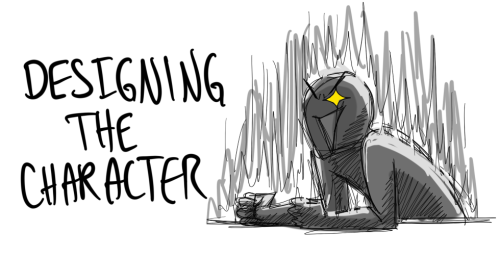
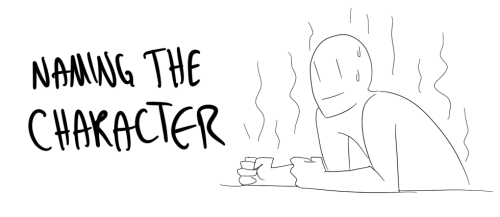
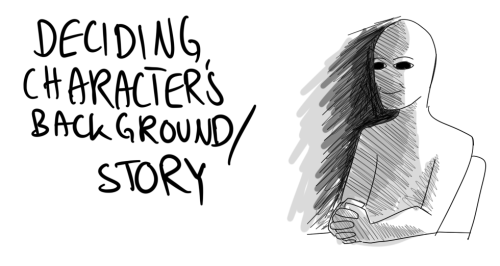
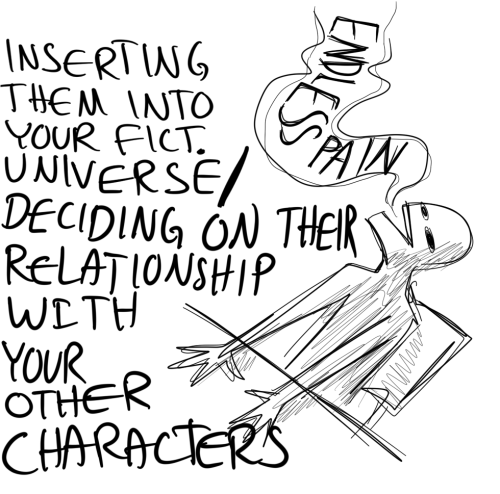
the suffering never ends
Sailors & Other Sea Travellers - Superstition & Folklore

”Red skies at night, sailor’s delight. Red skies at morning, sailor take warning.”
Lore

Davy Jones is a popular character in sailor’s yore, especially of the gothic variety. Davy Jones’ Locker, is an idiom for the bottom of the sea: the state of death for drowned sailors. The origins of the name are unclear, and many theories have been put forth, including:
An actual David Jones, who was a pirate on the Indian Ocean in the 1630s.
A pub owner who kidnapped sailors and then dumped them onto any passing ship.
The incompetent Duffer Jones, a myopic sailor who often found himself over-board.
Or that Davy Jones is another name for Satan or “Devil Jonah”, the biblical Jonah who became the “evil angel” of all sailors. Due to this, sailors with the name “Jonah” were bad luck to have abroad.
Upon death, a wicked sailor’s body supposedly went to Davy Jones’ locker (a chest, as lockers were back then), but a pious sailor’s soul went to Fiddler’s Green (in maritime folklore it is a kind of afterlife for sailors who have served at least 50 years at sea).
At Fiddler’s Green, where seamen true When here they’ve done their duty The bowl of grog shall still renew And pledge to love and beauty.
Dolphins and albatrosses were said to be the reincarnated souls of dead sailors; and sailors could not kill either of them.
Mermaids & Mermen

The legend of the mermaid, a creature with the upper body of a human and the lower body of a fish, has circulated the worlds oceans as far back as 5,000 B.C.
One of the earliest scientific accounts of the mermaid was documented by the great historian Pliny The Elder in 586 A.D. Pliny the Elder was convinced of the existence of mermaids and described them as “rough and scaled all over.” Since that time, and well before, thousands of sailors across the globe have reported seeing mermaids swimming off the bows of their ships. Even the famous Christopher Columbus reported an encounter with a mermaid; in January of 1493 Columbus reported that he saw three mermaids fin the ocean just off Haiti.
Mermaids were often considered lucky, but not universally. In Trinidad and Tobago, sea-dwelling mermen “were known to grant a wish, transform mediocrity into genius and confer wealth and power.” Mermaids appear in British folklore as unlucky omens, both foretelling disaster and provoking it.
Sailors would look for mermaid’s purses (the egg case of a skate, ray or shark; one of the most common objects washed up on the sea) on beaches for signs of mermaids in the area.
Klabautermann

Traditionally, a type of kobold, a Klabautermann, lives aboard ships and helps sailors and fishermen on the Baltic or North Sea in their duties. He is a merry and diligent creature, with an expert understanding of most watercraft, and an unsupressable musical talent. He also rescues sailors washed overboard. The belief in Klabautermanns dates to at least the 1770s.
A carved Klabautermann image, of a small sailor dressed in yellow with a tobacco pipe and wooden sailor’s cap, often wearing a caulking hammer, is attached to the mast as a symbol of good luck.
However, despite the positive attributes, there is one omen associated with his presence: no member of a ship blessed by his presence shall ever set eyes on him; he only ever becomes visible to the crew of a doomed ship.
More recently, the Klabautermann is sometimes described as having more sinister attributes, and blamed for things that go wrong on the ship. This incarnation of the Klabautermann is more demon- or goblin-like, prone to play pranks and, eventually, doom the ship and her crew. This deterioration of image probably stems from sailors, upon returning home, telling stories of their adventures at sea.
Sailor Tattoos

Sailors believed that certain symbols and talismans would help them in when facing certain events in life; they thought that those symbols would attract good luck or bad luck in the worst of the cases:
Sailors, at the constant mercy of the elements, often feel the need for religious images on their bodies to appease the angry powers that caused storms and drowning far from home.
The images of a pig and a hen were good luck; both animals are not capable of swimming, but they believed that God would look down upon a shipwreck and see an animal not capable of swimming and would take them into his hand and place them on land. Sailors had the belief that by wearing the North Star, this symbol would help them to find his or her way home.
The Flying Dutchman

The Flying Dutchman is a legendary ghost ship that can never make port and is doomed to sail the oceans forever. The myth is likely to have originated from 17th-century nautical folklore. The oldest extant version dates to the late 18th century. Sightings in the 19th and 20th centuries reported the ship to be glowing with ghostly light. If hailed by another ship, the crew of the Flying Dutchman will try to send messages to land, or to people long dead. In ocean lore, the sight of this phantom ship is a portent of doom.
Some say that The Flying Dutchman was used for piracy and was loaded with gold and other loot. While travelling with a load of treasure, unspeakable crimes were committed on board the ship, thus making it cursed forever.
“originally a vessel loaded with great wealth, on board of which some horrid act of murder and piracy had been committed” and that the apparition of the ship “is considered by the mariners as the worst of all possible omens.”
Other variations of the legend say that the Captain of The Flying Dutchman refused to go to port in the face of a horrible storm and as a result the entire ship perished. Others claim that the ship was not called The Flying Dutchman - that instead it was the name of the captain of the ship. Eventually, as people passed the legend down through the generations, the story of The Flying Dutchman referred to the ship.
Superstitions

Bad luck:
No bananas on board - At the height of the trading empire between Spain and the Caribbean in the 1700’s, most cases of disappearing ships happened to be carrying a cargo of bananas at the time.
No women on board - Women were said to bring bad luck on board because they distracted the sailors from their sea duties. This kind of behaviour angered the intemperate seas that would take their revenge out on the ship. However, images of naked women were carved onto the bow of the ship because the woman’s bare breasts ”shamed the stormy seas into calm” and her open eyes guided the seamen to safety.
No whistling on board - Mariners have long held the belief that whistling or singing into the wind will “whistle up a storm”.
Deathly lexis - At sea, some words must be strictly avoided to ensure the ship and crew’s safe return. These include obvious ones like “drowned” and “goodbye”. If someone says “good luck” to you, it is sure to bring about bad luck. The only way to reverse the curse is by drawing blood.
Lurking sharks - A shark following the ship is a sign of inevitable death.
Unlucky days: - Fridays: Fridays have long been considered unlucky days, likely because Jesus Christ was crucified on a Friday. - Thursdays: Thursdays are bad sailing days because that is Thor’s day, the god of thunders and storms. - First Monday in April: The first Monday in April is the day Cain slew Abel. - Second Monday in August: The second Monday in August is the day the kingdoms of Sodom and Gomorrah were destroyed. - Superstitious sailor believed that the only good day to sail on was sundays.
Changing the name of the boat - Boats develop a life and mind of their own once they are named and Christened. If you do rename the boat- you absolutely must have a de-naming ceremony. This ceremony can be performed by writing the current boat name on a piece of paper, folding the paper and placing it in a wooden box then burning the box. After, the ashes were scooped up and thrown into the sea.
Red heads - Red heads were thought to bring bad luck to a ship if you happened to encounter one before boarding. However, if you speak to the redhead before they get the chance to speak to you, it is cancelled out.
Good luck:
It is good luck to spit in the ocean before you sail.
Coins thrown into the sea as a boat leaves port is a small toll to Neptune, the sea god, for a safe voyage.
Horseshoes on a ship’s mast will turn away a storm.
Cats brought luck. If a ship’s cat came to a sailor, it meant good luck.
Pouring wine on the deck will bring good luck on a long voyage.
It is often considered lucky to touch the collar of a sailor’s suit.
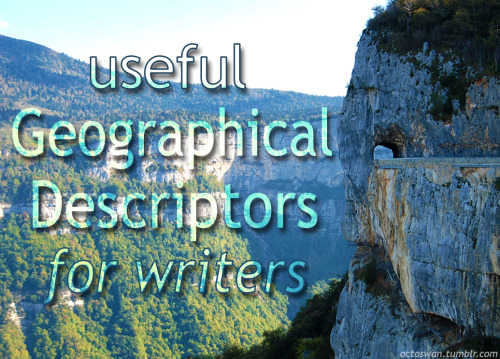


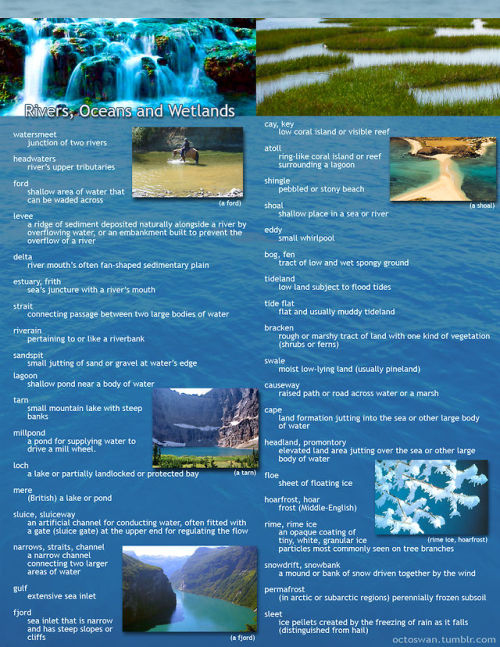
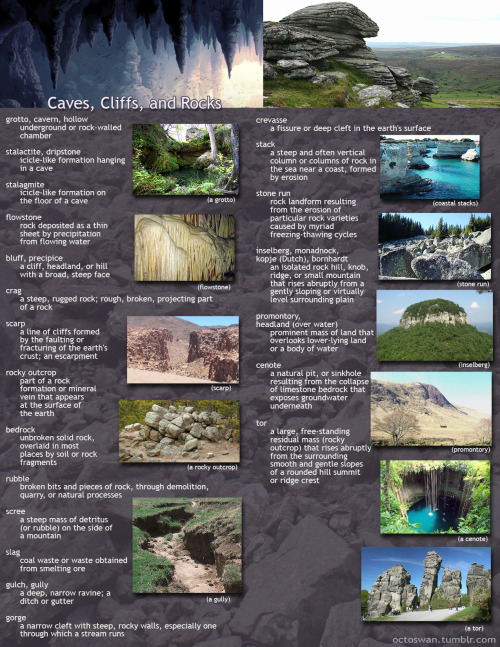
I made these as a way to compile all the geographical vocabulary that I thought was useful and interesting for writers. Some descriptors share categories, and some are simplified, but for the most part everything is in its proper place. Not all the words are as useable as others, and some might take tricky wording to pull off, but I hope these prove useful to all you writers out there!
(save the images to zoom in on the pics)
sometimes you need dialogue tags and don't want to use the same four


If animals, real or imaginary, feature heavily in your story, give this a read. In fiction, carnivores are frequently depicted as incredibly vicious and as attacking every other living creature on sight, whereas herbivores are depicted as gentle, benign, and typically only hurt humans on accident if they panic, such as by rearing or stampeding. This is bullshit. Firstly, many herbivores are incredibly vicious and are in fact far more likely to attack a person just for being nearby. This especially goes for large herd ungulates like rhinos, hippos, Cape buffalo, and moose. All of these are highly aggressive to humans and in general. Bison are considerably more chill than their African cousins, but they still send tourists flying (sometimes to their graves) in Yellowstone due to people trying to get too close and treat them like a petting zoo. Deer, often imagined as the pinnacle of fearful and delicate, will typically choose flight over fight…but should they choose to fight, especially a male in rut or a female with a fawn, they can and will kill a human being. Even a rabbit will do its best to fuck someone up if they feel they are threatened. Remember, every animal will fight for its life with all its got, and to herbivores, EVERYTHING is a potential threat. If an animal they’re not familiar with as “safe” is nearby, they will assume it’s a threat. There are some prey animals that are surprisingly docile—videos I’ve seen of people interacting with a wild potoroo and a Bosavi wooly rat show them to be incredibly chill, and the quokka is famous for its lack of fear towards humans—but these are the exception, not the rule. Wild carnivores aren’t cute pets just waiting for the right special animal-loving protagonist to take them home, but they aren’t these constantly-aggressive, constantly-angry, constantly-ravenous monsters either that so much media makes out. They most certainly will hunt when they’re hungry, and in the rare instance they decide to make a meal of a human, that human is indeed fucked (it’s hilarious to me how many people think they could fight off a lion, tiger, etc.) but unless it’s truly starving and desperate* most of them are not going to make a point of pursuing a potential meal, human or otherwise, to the exclusion of all else. Especially not if there’s other options around. Why expend all these energy chasing after the protagonists if there’s literally anything else they could catch and eat instead? And why do so many of these monster-animals seem so interested in catching and killing the protagonists, but not in actually eating them; a ridiculous number of predators in fiction will straight-up leave the body of a person they JUST killed behind in order to catch another human. Why? This makes no sense, I don’t care if it’s a fictional animal like a dragon or manticore, it’s not conducive to survival. Unless this animal is MEANT to have an actual sentient grudge (which CAN happen, a man in Russia once shot a tiger and took its kill; the tiger waited for him in his cabin when he returned) do away with the Super Persistent Predator trope. Especially when it’s an animal like a great white shark, whose preferred prey not only isn’t humans, we’re actually downright nasty to them because we don’t have the fat content of the seals and sea lions they typically eat (most great white “attacks” are just them checking us out or mistaking us for a delicious sea mammal) There are exceptions to this rant, though most are small creatures. For instance, stoats do engage in “surplus killing” and stockpile the bodies, and shrews are very aggressive little predators due to having incredibly fast metabolisms that mean they basically have to eat all the time to stay alive. And, yes, there are some large ones; the tiger shark will eat anything, bull sharks are pretty bad to be around, and the polar bear has actively hunted humans when the opportunity presents itself. But as with the “super gentle chill wild herbivore that is basically domesticated” they are the exceptions. And I’m sure you know of other exceptions; the fact they are “exceptions” in the first place means it’s NOT the norm. If there’s a reason the animals in your story are hyper-aggressive and persistent to a point they seem almost consciously evil, that’s fine—genetically engineered that way, for instance—but have there be a REASON. It’s seldom the default in nature. Think of it this way: You’d fight a lot harder to save your life than you would to get a hamburger (unless saving your life required that hamburger). Consider that when you write real animals, and when you craft fictional ones. (* Which admittedly most real life man-eaters are; most large mammals that turn to actively hunting humans have been sick, elderly, or injured in such a way they can’t pursue their normal prey. But in fiction, the animals that are absurdly focused on eating humans alone always seem in perfect health and are seldom revealed as otherwise, or even having a reason at all. It’s just presented as their default behavior. Which it is not. That’s the point of this rant.)
